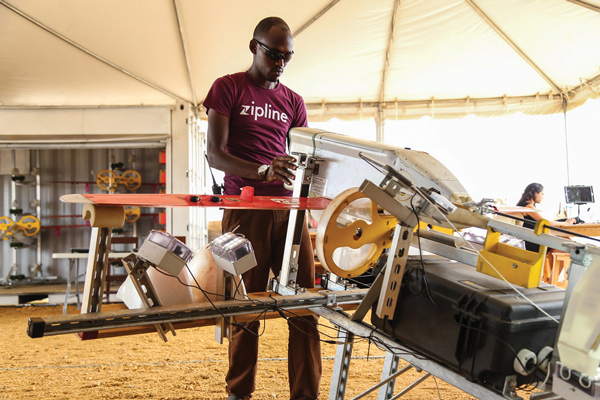November 22, 2019
Could vaccines reach remote areas … remotely?
Drone delivery may help overcome the challenge of getting medicines and vaccines to hard-to-reach populations.
Michael Dumiak
Some of the longstanding obstacles to improving access to vaccines are often as basic as desert, jungle, or mountain. Small aircraft that are piloted remotely, or drones—those as simple as the ones taking Instagram video, or the more sophisticated machines that look like oversized flying spiders—have made enough progress to at least capture the imagination of public health workers trying to get over these obstacles and get vaccines, medicines, and other health supplies to people who need them.
At the World Health Summit in Berlin in October 2019, the World Health Organization’s (WHO) chief information officer, Bernardo Mariano, outlined a vision of digital health—bolstered by a new WHO department of digital health, which he heads—by giving a mention to Ghana’s ongoing experiments with using Zipline drones to quickly deliver blood for transfusion in the more remote parts of the country (see photo).
Drone delivery in public health is also drawing some criticism, the argument being that Silicon Valley-backed remote tech solutions are a distraction from building basic infrastructure. But it’s a complicated issue. Even in a country with more advanced infrastructure, such as Rwanda or South Africa, the distances between health outposts can be vast and the supply logistics very challenging. Only 25% of Rwanda’s mountainous roads are paved. These obstacles are a real part of what Seth Berkley, chief executive of Gavi, the Vaccine Alliance, outlined on a panel in Berlin as the “last mile” that keeps people from needed medical treatment and basic vaccinations. Keeping vaccines refrigerated at subzero temperatures and getting them through heat and rugged terrain is a problem drawing many ideas, from solar-powered refrigerators in Yemen to camel-carried passive coolers.
 Zipline is among many companies looking for new ways to get medicines and vaccines to inaccessible areas. Credit: World Bank Photo Collection licensed under CC BY-NC-ND 2.0.
Zipline is among many companies looking for new ways to get medicines and vaccines to inaccessible areas. Credit: World Bank Photo Collection licensed under CC BY-NC-ND 2.0.
And drones are now becoming part of the picture. This summer the Ghanaian drone pilot program started running out of the first of what will be four distribution centers in the country, ferrying blood north of the capital Accra. A year ago, the island nation of Vanuatu, with support from the United Nations Children’s Fund (UNICEF), employed a drone operated by Australian company Swoop Aero to drop hepatitis and tuberculosis vaccines following a 30-mile journey over water and mountains. Last July in the Bahamas, the organization Direct Relief, with partners Merck, AT&T, Softbox, and Volans-i, tested a drone in an autonomous flight carrying a specially designed temperature-controlled pharma payload box from island to island over open water. Merck did not say if real vaccine was in the payload box but they were able to monitor the box temperature remotely at minus 70 degrees Celsius, the level required for storing and transporting many vaccines and medicines.
While these larger organizations are drawing attention with their drone experiments, efforts at drone-building using off-the-shelf, relatively inexpensive products are popular—and quite creative—in the developing world. In Tanzania, for instance, local companies are building drones with propellers and bamboo frames. While airlifting medical supplies has a history going back to the first days of flight, this kind of do-it-yourself approach, paired with a little public health expertise, may be a more accessible way to help get over that difficult last mile for delivering medicines and vaccines to the world’s more difficult-to-reach populations.
Michael Dumiak, based in Berlin, reports on global science, public health, and technology.